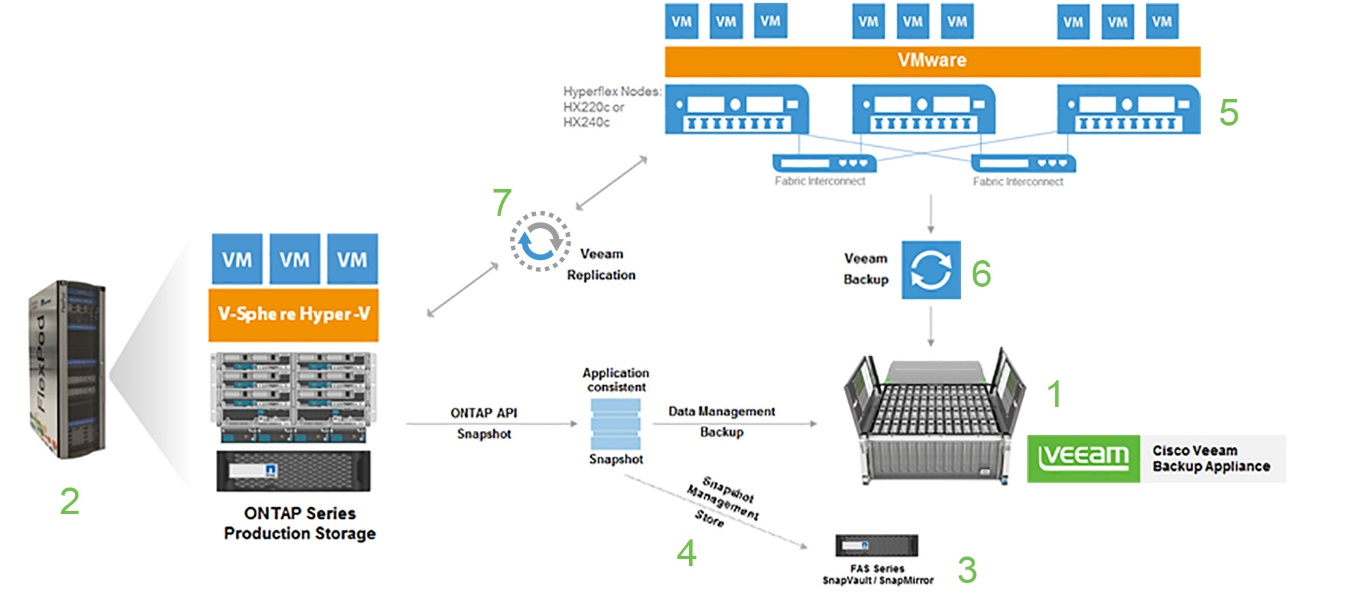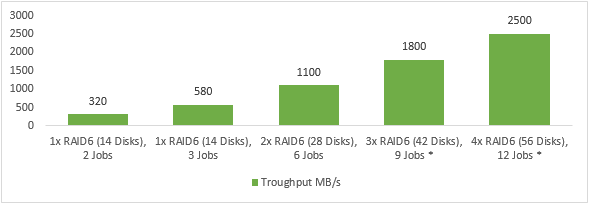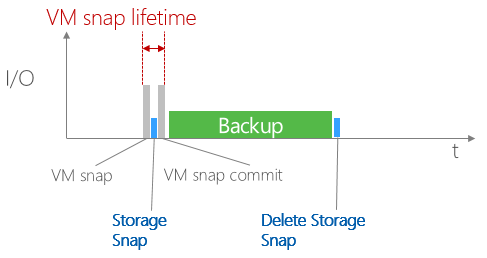Sample data center architecture based on Cisco, NetApp and Veeam solutions
Nowadays, the IT department is required to ensure the smooth operation of the company's data center, as any failure of the site, database, telephony, etc. can lead to financial and reputational losses. Therefore, the creation of standardized, reproducible and reliable reference architectures of their construction becomes an important part of the modernization of the data center. The reference architecture defines the technical characteristics and the approach to deployment, which, on the one hand, meet the specific needs of the business, and on the other, the fundamental principles for building highly reliable systems. The reference model includes a description of the composition and structure of components, as well as best practices in installing and configuring products that ensure optimal performance of the data center as a whole. This model serves as a convenient template when working on various projects of the IT department.
In order to design an IT infrastructure based on a data center reference model, you first need to clearly articulate the requirements and expectations for this infrastructure to work. Then you need to describe in detail the components you plan to use. The IT department needs a design that delivers the required performance, as well as failover protection and high data availability. As an example, consider the data center infrastructure model, which includes solutions from NetApp, Cisco, and Veeam.

')
Fig.1. Data Center Architecture Model Based on Cisco, NetApp, and Veeam
This model provides for the close cooperation of all manufacturers in order to create, test and verify the optimal configuration. Consider how the combination of the three technologies — network, storage and accessibility — allows you to design an architecture that meets the requirements of business and IT. Figure 1 shows how a data center can be built on its basis. The management and control of resource allocation for all data monitoring and protection tasks is performed by the Cisco Appliance for Veeam (# 1 in the figure). Cisco Backup Appliance helps you manage all types of tasks, be it backing up, replicating, working with the cloud, or monitoring a virtual environment.
During tests in the Veeam laboratory, such an infrastructure showed a bandwidth of 1.1 GB / s for a 3x60 node, reaching a value of 10 gigabits / s for an Ethernet connection. At the same time, the server node still had more than 60% of processor and RAM resources free. Based on the results of these tests, it can be expected that with a full load on the processor (and Ethernet connections operating at 40 gigabits per second and accordingly configured storage), the bandwidth for the 3x60 server will exceed 2.5 GB / s. Graphically, test results and expected values are shown in Fig.2.

* - with optimal configuration with C32600
Fig.2. Test data.
For the most critical Cisco / NetApp FlexPod applications (# 2 in diagram 1 above), it provides the necessary performance of computing and network resources, as well as storage resources. For backup and replication with FlexPod, the Veeam solution uses integration with NetApp DATA ONTAP hardware snapshots (see Figure 3).
This minimizes the utilization of VMware and / or production storage resources.

Fig.3. Integration with hardware snapshots of NetApp DATA ONTAP
During a backup or replication job, Veeam creates a VMware snapshot and then creates a hardware snapshot on NetApp. The VMware snapshot is immediately deleted because the hardware snapshot contains the VM in a consistent state. After performing a VMware snapshot commit, either Veeam switches the SnapMirror / SnapVault update to NetApp backup storage (# 3 in diagram 1) as the source, or VMware can start the backup directly from the primary storage. The NetApp hardware snapshot is then mounted on the Cisco Backup Appliance, and the task performs backup or replication. After the job is complete, the hardware snapshot is automatically deleted.
You can also use NetApp integration (see the post on Habré ) to manage ONTAP snapshots and control SnapMirror and SnapVault connections between several ONTAP systems (# 4 in Figure 1).
For less critical applications (for example, VDI infrastructure, branch network, test environment), you can provide the necessary control and performance using Cisco HyperFlex (# 5 in Figure 1). The Cisco Backup Appliance for Veeam is used to back up from a Cisco HyperFlex system (# 6 in diagram 1, as well as diagram 4) and to replicate virtual machines between HyperFlex and FlexPod systems (# 7 in diagram 1).
Cisco Backup Appliance provides flexible backup and data transfer capabilities for any site. In addition, these replicas can be used to automatically check recoverability with Veeam SureReplica.

Fig.4. Data transfer organization
It is not so important what industry you work in - the business continues to change faster and requires the IT infrastructure to be brought to a new level of adaptability and reliability - otherwise there is a risk of data loss, application and services failure, which may cause business loss in the form of lost profits . That is why we consider it important to work out universal reference models for building a data center in terms of reliability, fault tolerance and final performance.
More detailed materials that will help you in creating an architecture model can be read in English:
In order to design an IT infrastructure based on a data center reference model, you first need to clearly articulate the requirements and expectations for this infrastructure to work. Then you need to describe in detail the components you plan to use. The IT department needs a design that delivers the required performance, as well as failover protection and high data availability. As an example, consider the data center infrastructure model, which includes solutions from NetApp, Cisco, and Veeam.

')
Fig.1. Data Center Architecture Model Based on Cisco, NetApp, and Veeam
This model provides for the close cooperation of all manufacturers in order to create, test and verify the optimal configuration. Consider how the combination of the three technologies — network, storage and accessibility — allows you to design an architecture that meets the requirements of business and IT. Figure 1 shows how a data center can be built on its basis. The management and control of resource allocation for all data monitoring and protection tasks is performed by the Cisco Appliance for Veeam (# 1 in the figure). Cisco Backup Appliance helps you manage all types of tasks, be it backing up, replicating, working with the cloud, or monitoring a virtual environment.
During tests in the Veeam laboratory, such an infrastructure showed a bandwidth of 1.1 GB / s for a 3x60 node, reaching a value of 10 gigabits / s for an Ethernet connection. At the same time, the server node still had more than 60% of processor and RAM resources free. Based on the results of these tests, it can be expected that with a full load on the processor (and Ethernet connections operating at 40 gigabits per second and accordingly configured storage), the bandwidth for the 3x60 server will exceed 2.5 GB / s. Graphically, test results and expected values are shown in Fig.2.

* - with optimal configuration with C32600
Fig.2. Test data.
For the most critical Cisco / NetApp FlexPod applications (# 2 in diagram 1 above), it provides the necessary performance of computing and network resources, as well as storage resources. For backup and replication with FlexPod, the Veeam solution uses integration with NetApp DATA ONTAP hardware snapshots (see Figure 3).
This minimizes the utilization of VMware and / or production storage resources.

Fig.3. Integration with hardware snapshots of NetApp DATA ONTAP
During a backup or replication job, Veeam creates a VMware snapshot and then creates a hardware snapshot on NetApp. The VMware snapshot is immediately deleted because the hardware snapshot contains the VM in a consistent state. After performing a VMware snapshot commit, either Veeam switches the SnapMirror / SnapVault update to NetApp backup storage (# 3 in diagram 1) as the source, or VMware can start the backup directly from the primary storage. The NetApp hardware snapshot is then mounted on the Cisco Backup Appliance, and the task performs backup or replication. After the job is complete, the hardware snapshot is automatically deleted.
You can also use NetApp integration (see the post on Habré ) to manage ONTAP snapshots and control SnapMirror and SnapVault connections between several ONTAP systems (# 4 in Figure 1).
For less critical applications (for example, VDI infrastructure, branch network, test environment), you can provide the necessary control and performance using Cisco HyperFlex (# 5 in Figure 1). The Cisco Backup Appliance for Veeam is used to back up from a Cisco HyperFlex system (# 6 in diagram 1, as well as diagram 4) and to replicate virtual machines between HyperFlex and FlexPod systems (# 7 in diagram 1).
Cisco Backup Appliance provides flexible backup and data transfer capabilities for any site. In addition, these replicas can be used to automatically check recoverability with Veeam SureReplica.

Fig.4. Data transfer organization
It is not so important what industry you work in - the business continues to change faster and requires the IT infrastructure to be brought to a new level of adaptability and reliability - otherwise there is a risk of data loss, application and services failure, which may cause business loss in the form of lost profits . That is why we consider it important to work out universal reference models for building a data center in terms of reliability, fault tolerance and final performance.
Additional materials
More detailed materials that will help you in creating an architecture model can be read in English:
Source: https://habr.com/ru/post/301770/
All Articles